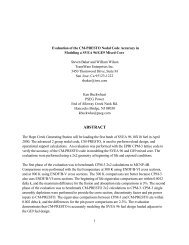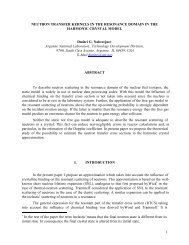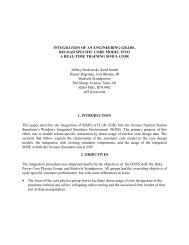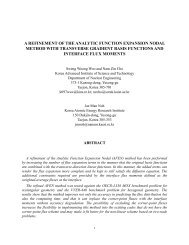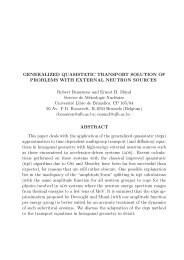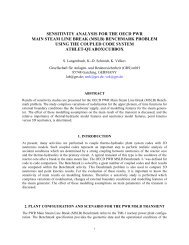Ellis
Ellis
Ellis
You also want an ePaper? Increase the reach of your titles
YUMPU automatically turns print PDFs into web optimized ePapers that Google loves.
Results shown in Tables III and IV allow a comparison of VVER and PWR void reactivity<br />
effects: though there are some differences in pin geometries and pitch (resulting in the kinf<br />
differences) the values for the void reactivities are very similar for VVER and PWR reactors.<br />
4.2 RELATIVE TEMPERATURE AND DENSITY EFFECTS IN MTC CONSIDERATIONS<br />
To assess phenomena associated with an actual moderator temperature coefficient (MTC), an<br />
additional series of SAS2H and HELIOS calculations were performed for a coolant temperature<br />
change that would result in an exact 10% coolant density change (the fuel temperature was not<br />
changed in these calculations): At 536.8K, the coolant density is 0.791 g/cm 3 ; at 580.0K, the<br />
coolant density is 0.712 g/cm 3 , exactly 10% less. For this example, the SAS2H and HELIOS<br />
cases did not include boron in the coolant.<br />
There were consistent results between the SAS2H and HELIOS calculations. The reactivity<br />
effect due to the +43.2K coolant temperature change alone is about -0.04% for LEU, -0.08% for<br />
RG, and -0.11% for WG; this compares to -1.1% to -1.5% for the partial reactivity effect of the<br />
coolant density change alone.<br />
4.3 VOID REACTIVITY IN PWRs FOR RANGES OF LEU AND MOX ENRICHMENTS<br />
Since a realistic operating reactor has a distribution of fuel burnups, it is important to assess the<br />
void reactivity effect as a function of burnup. To accomplish this, HELIOS cases were prepared<br />
for VVER geometries and standard PWR fuel pin geometry. HELIOS cases modeled the burnup<br />
of the appropriate LEU or MOX fuel from 0 to 40 MWd/kgHE burnup, and simulated voiding at<br />
different burnup points. Burnup of 20 MWd/kgHE is representative of midburnup for the fuel;<br />
this approximates the average conditions and fuel burnup for an equilibrium operating PWR.<br />
Table V presents an overview of void reactivity effects for fresh and midburnup LEU, WG, and<br />
RG fuel for 10% voiding up to 90% voiding.<br />
Table V. Reactivity Effects (%) From Voiding: HELIOS Calcs, With Boron in the Coolant<br />
Fuel<br />
10% void;<br />
0 MWd/kgHE<br />
10% void;<br />
20 MWd/kgHE<br />
50% void;<br />
0 MWd/kgHE<br />
7<br />
50% void;<br />
20 MWd/kgHE<br />
90% void;<br />
0 MWd/kgHE<br />
90% void;<br />
20 MWd/kgHE<br />
LEU 3.5 wt% -1.12 -1.87 -10.26 -15.35 -49.43 -58.32<br />
Nominal WG -1.50 -2.05 -11.92 -15.78 -44.57 -51.84<br />
Nominal RG -1.32 -1.38 -7.22 -7.43 -11.76 -11.30<br />
From the above results, for the representative fuel compositions considered, the void reactivity<br />
effect becomes more negative for each of the fuel types as the degree of voiding is increased.<br />
However, while for the modest 10% voiding the reactivity effect is less negative in LEU than in<br />
MOX and WG is more negative than RG; for large voids (90%), LEU is considerably more<br />
negative than MOX but RG is much less negative than WG.



